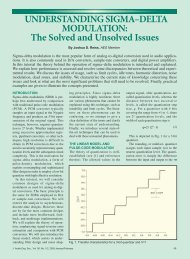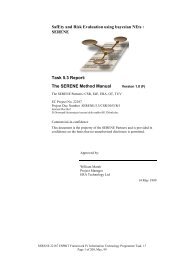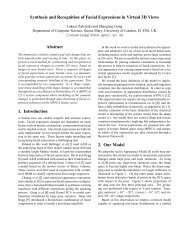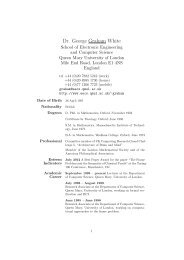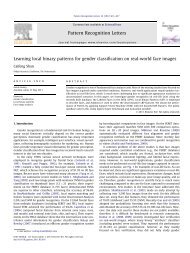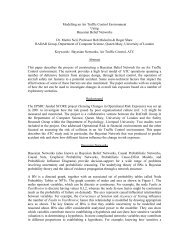DEAP: A Database for Emotion Analysis using Physiological Signals
DEAP: A Database for Emotion Analysis using Physiological Signals
DEAP: A Database for Emotion Analysis using Physiological Signals
Create successful ePaper yourself
Turn your PDF publications into a flip-book with our unique Google optimized e-Paper software.
IEEE TRANS. AFFECTIVE COMPUTING 5<br />
Fig. 1. Screenshot of the web interface <strong>for</strong> subjective<br />
emotion assessment.<br />
the clips was randomized, but preference was given to<br />
the clips rated by the least number of participants. This<br />
ensured a similar number of ratings <strong>for</strong> each video (14-<br />
16 assessments per video were collected). It was ensured<br />
that participants never saw the same video twice.<br />
After all of the 120 videos were rated by at least<br />
14 volunteers each, the final 40 videos <strong>for</strong> use in the<br />
experiment were selected. To maximize the strength of<br />
elicited emotions, we selected those videos that had the<br />
strongest volunteer ratings and at the same time a small<br />
variation. To this end, <strong>for</strong> each video x we calculated<br />
a normalized arousal and valence score by taking the<br />
mean rating divided by the standard deviation (µx/σx).<br />
Then, <strong>for</strong> each quadrant in the normalized valencearousal<br />
space, we selected the 10 videos that lie closest<br />
to the extreme corner of the quadrant. Fig. 2 shows<br />
the score <strong>for</strong> the ratings of each video and the selected<br />
videos highlighted in green. The video whose rating<br />
was closest to the extreme corner of each quadrant is<br />
mentioned explicitly. Of the 40 selected videos, 17 were<br />
selected via Last.fm affective tags, indicating that useful<br />
stimuli can be selected via this method.<br />
3 EXPERIMENT SETUP<br />
3.1 Materials and Setup<br />
The experiments were per<strong>for</strong>med in two laboratory<br />
environments with controlled illumination. EEG and<br />
peripheral physiological signals were recorded <strong>using</strong> a<br />
Biosemi ActiveTwosystem 4 on a dedicatedrecordingPC<br />
(Pentium 4, 3.2 GHz). Stimuli were presented <strong>using</strong> a<br />
dedicated stimulus PC (Pentium 4, 3.2 GHz) that sent<br />
4. http://www.biosemi.com<br />
Valence score<br />
2<br />
1.5<br />
1<br />
0.5<br />
0<br />
−0.5<br />
−1<br />
−1.5<br />
Sia<br />
Breathe me<br />
−2<br />
−2<br />
Louis Armstrong<br />
What a wonderful world<br />
Blur<br />
Song 2<br />
Napalm death<br />
Procrastination on the<br />
empty vessel<br />
−1.5 −1 −0.5 0 0.5 1 1.5 2<br />
Arousal score<br />
Fig. 2. µx/σx value <strong>for</strong> the ratings of each video in<br />
the online assessment. Videos selected <strong>for</strong> use in the<br />
experiment are highlighted in green. For each quadrant,<br />
the most extreme video is detailed with the song title and<br />
a screenshot from the video.<br />
synchronization markers directly to the recording PC.<br />
For presentation of the stimuli and recording the users’<br />
ratings, the ”Presentation” software by Neurobehavioral<br />
systems 5 was used. The music videos were presented<br />
on a 17-inch screen (1280 × 1024, 60 Hz) and in order<br />
to minimize eye movements, all video stimuli were<br />
displayed at 800× 600 resolution, filling approximately<br />
2/3 of the screen. Subjects were seated approximately<br />
1 meter from the screen. Stereo Philips speakers were<br />
used and the music volume was set at a relatively loud<br />
level, however each participant was asked be<strong>for</strong>e the<br />
experiment whether the volume was com<strong>for</strong>table and it<br />
was adjusted when necessary.<br />
EEG was recorded at a sampling rate of 512 Hz <strong>using</strong><br />
32 active AgCl electrodes (placed according to the international<br />
10-20system). Thirteenperipheral physiological<br />
signals (which will be further discussed in section 6.1)<br />
were also recorded. Additionally, <strong>for</strong> the first 22 of the<br />
32 participants, frontal face video was recorded in DV<br />
quality <strong>using</strong> a Sony DCR-HC27E consumer-grade camcorder.Thefacevideowasnotusedintheexperimentsin<br />
this paper, but is made publicly available along with the<br />
rest of the data. Fig. 3 illustrates the electrode placement<br />
<strong>for</strong> acquisition of peripheral physiological signals.<br />
3.2 Experiment protocol<br />
32 Healthy participants (50% female), aged between 19<br />
and 37 (mean age 26.9), participated in the experiment.<br />
Prior to the experiment, each participant signed a consent<br />
<strong>for</strong>m and filled out a questionnaire. Next, they were<br />
given a set of instructions to read in<strong>for</strong>ming them of the<br />
experiment protocol and the meaning of the different<br />
scales used <strong>for</strong> self-assessment. An experimenter was<br />
also present there to answer any questions. When the<br />
5. http://www.neurobs.com




